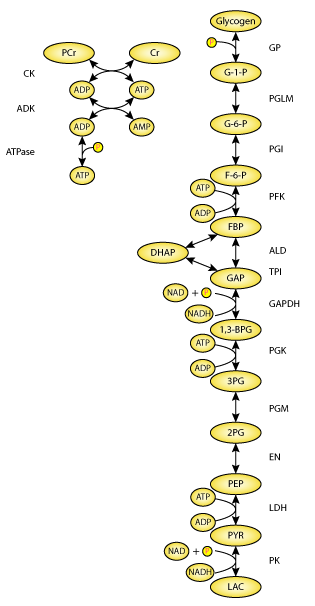Lambeth, Kushmerick, 2002
Model Status
This CellML model runs in both OpenCell and COR. The units have been checked and they are consistent. However the model in its present state does not recreate the published results.
Model Structure
ABSTRACT: A dynamic model of the glycogenolytic pathway to lactate in skeletal muscle was constructed with mammalian kinetic parameters obtained from the literature. Energetic buffers relevant to muscle were included. The model design features stoichiometric constraints, mass balance, and fully reversible thermodynamics as defined by the Haldane relation. We employed a novel method of validating the thermodynamics of the model by allowing the closed system to come to equilibrium; the combined mass action ratio of the pathway equaled the product of the individual enzymes' equilibrium constants. Adding features physiologically relevant to muscle-a fixed glycogen concentration, efflux of lactate, and coupling to an ATPase-allowed for a steady-state flux far from equilibrium. The main result of our analysis is that coupling of the glycogenolytic network to the ATPase transformed the entire complex into an ATPase driven system. This steady-state system was most sensitive to the external ATPase activity and not to internal pathway mechanisms. The control distribution among the internal pathway enzymes-although small compared to control by ATPase-depended on the flux level and fraction of glycogen phosphorylase a. This model of muscle glycogenolysis thus has unique features compared to models developed for other cell types.
The original paper reference is cited below:
A Computational Model for Glycogenolysis in Skeletal Muscle, Melissa J. Lambeth and Martin J. Kushmerick, 2002, Annals of Biomedical Engineering, 30, 808-827. PubMed ID: 12220081
 |
| A schematic diagram of the reactions used in the model of the glycogenolysis pathway in skeletal muscle. |

